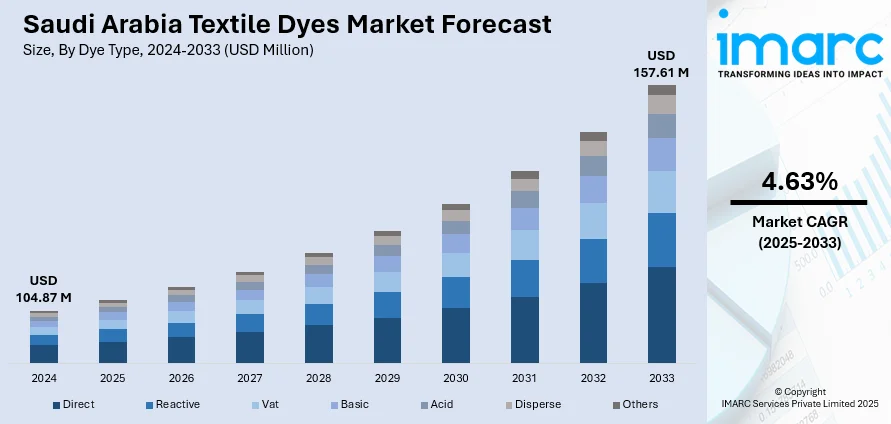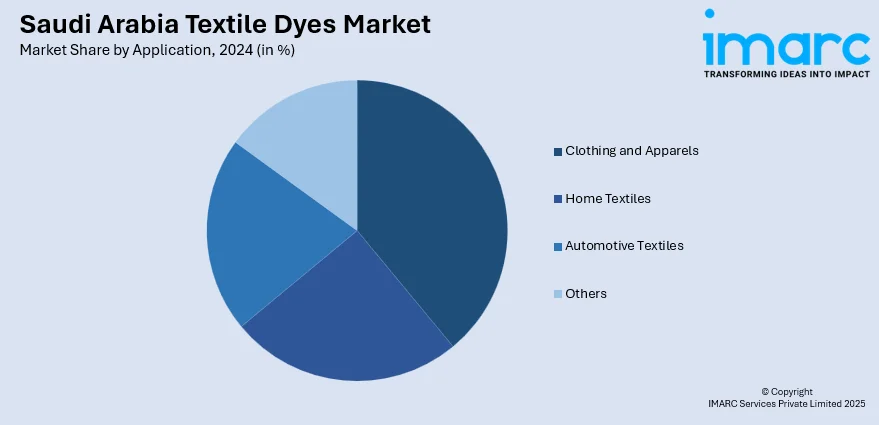
Saudi Arabia Textile Dyes Market Size, Share, Trends and Forecast by Dye Type, Fiber Type, Application, and Region, 2025-2033
Saudi Arabia Textile Dyes Market Overview:
The Saudi Arabia textile dyes market size reached USD 104.87 Million in 2024. Looking forward, IMARC Group expects the market to reach USD 157.61 Million by 2033, exhibiting a growth rate (CAGR) of 4.63% during 2025-2033. At present, advancements in textile machinery and automation are refining dye application processes, making them faster and more efficient. Besides this, the broadening of online retail platforms that allow smaller fashion and home-apparel brands to reach a wider customer base is contributing to the expansion of the Saudi Arabia textile dyes market share.
|
Report Attribute
|
Key Statistics
|
|---|---|
|
Base Year
|
2024 |
|
Forecast Years
|
2025-2033
|
|
Historical Years
|
2019-2024
|
| Market Size in 2024 | USD 104.87 Million |
| Market Forecast in 2033 | USD 157.61 Million |
| Market Growth Rate 2025-2033 | 4.63% |
Saudi Arabia Textile Dyes Market Trends:
Expansion of textile manufacturing and production units
The expansion of textile manufacturing and production units is positively influencing the market. As new textile factories are opening and existing ones are expanding, the usage of dyes is rising to meet the growing need for vibrant and durable fabrics. Manufacturers require a wide range of dyes for catering to different textile segments, including apparel, home furnishings, and technical textiles. This broadening is promoting innovations and enabling dye producers to supply eco-friendly, cost-effective, and application-specific items. An increase in domestic textile production is reducing reliance on imports and supporting local dye suppliers. Moreover, advancements in textile machinery and automation enhance dye application processes, making them faster and more efficient. Government agencies are implementing technical guidelines to encourage investments in the textile sector. In January 2024, governing agencies of Saudi Arabia introduced a new version of its Technical Regulations for textile products. The updated policies set crucial criteria for textile goods and described the conformity assessment processes that suppliers needed to adhere to in order to ensure their products comply with standards for access to the Saudi Arabian market. The rising demand for customized and fashion-forward garments is promoting the utilization of specialty dyes.

Growing applications in automotive industry
Increasing applications of textile dyes in the automotive industry are offering a favorable market outlook. With rising vehicle production, car manufacturers are using dyed textiles for seats, carpets, door panels, and headliners, requiring durable, ultraviolet (UV)-resistant, and aesthetically pleasing dye solutions. As per industry reports, in 2024, Saudi roads welcomed 827,857 new light vehicles, marking a robust 6.6% growth compared to 2023. As the automotive sector is thriving in the country, especially with local production initiatives and high vehicle ownership, the need for specialized dyes is increasing. Manufacturers prefer dyes that offer colorfastness, sustainability, and compatibility with various textile materials. The trend of luxurious and customized interiors is promoting the employment of vibrant and diverse dye options. Additionally, innovations in automotive design and materials are leading dye producers to develop new formulations. Consequently, textile dye suppliers are finding new opportunities to meet the evolving requirements of the automotive industry, helping expand the textile dyes market in Saudi Arabia.
Broadening of e-commerce portals
The expansion of e-commerce sites is impelling the Saudi Arabia textile dyes market growth. Online retail platforms allow smaller fashion and home-textile brands to reach a wider customer base, creating the need for unique color offerings and small-batch dye services. As people are browsing and purchasing textiles online, they are expecting accurate color representation and fast delivery, motivating manufacturers to adopt advanced dyeing processes and digital color matching technologies. E-commerce also promotes seasonal trends and limited-edition collections, encouraging frequent product updates and higher dye utilization. Additionally, online marketplaces support direct-to-consumer (D2C) textile startups that seek specialized dyes for niche applications, such as sustainable and smart fabrics. The rise of e-commerce platforms in the country is enhancing accessibility and stimulating innovations in the textile dyes industry. According to the IMARC Group, the Saudi Arabia e-commerce market is set to attain USD 708.7 Billion by 2033, exhibiting a growth rate (CAGR) of 12.8% during 2025-2033.
Saudi Arabia Textile Dyes Market Segmentation:
IMARC Group provides an analysis of the key trends in each segment of the market, along with forecasts at the country and regional levels for 2025-2033. Our report has categorized the market based on dye type, fiber type, and application.
Dye Type Insights:
- Direct
- Reactive
- Vat
- Basic
- Acid
- Disperse
- Others
The report has provided a detailed breakup and analysis of the market based on the dye type. This includes direct, reactive, vat, basic, acid, disperse, and others.
Fiber Type Insights:
- Wool
- Nylon
- Cotton
- Viscose
- Polyester
- Others
A detailed breakup and analysis of the market based on the fiber type have also been provided in the report. This includes wool, nylon, cotton, viscose, polyester, and others.
Application Insights:

- Clothing and Apparels
- Home Textiles
- Automotive Textiles
- Others
The report has provided a detailed breakup and analysis of the market based on the application. This includes clothing and apparels, home textiles, automotive textiles, and others.
Regional Insights:
- Northern and Central Region
- Western Region
- Eastern Region
- Southern Region
The report has also provided a comprehensive analysis of all the major regional markets, which include Northern and Central Region, Western Region, Eastern Region, and Southern Region.
Competitive Landscape:
The market research report has also provided a comprehensive analysis of the competitive landscape. Competitive analysis such as market structure, key player positioning, top winning strategies, competitive dashboard, and company evaluation quadrant has been covered in the report. Also, detailed profiles of all major companies have been provided.
Saudi Arabia Textile Dyes Market Report Coverage:
| Report Features | Details |
|---|---|
| Base Year of the Analysis | 2024 |
| Historical Period | 2019-2024 |
| Forecast Period | 2025-2033 |
| Units | Million USD |
| Scope of the Report |
Exploration of Historical Trends and Market Outlook, Industry Catalysts and Challenges, Segment-Wise Historical and Future Market Assessment:
|
| Dye Types Covered | Direct, Reactive, Vat, Basic, Acid, Disperse, Others |
| Fiber Types Covered | Wool, Nylon, Cotton, Viscose, Polyester, Others |
| Applications Covered | Clothing and Apparels, Home Textiles, Automotive Textiles, Others |
| Regions Covered | Northern and Central Region, Western Region, Eastern Region, Southern Region |
| Customization Scope | 10% Free Customization |
| Post-Sale Analyst Support | 10-12 Weeks |
| Delivery Format | PDF and Excel through Email (We can also provide the editable version of the report in PPT/Word format on special request) |
Key Questions Answered in This Report:
- How has the Saudi Arabia textile dyes market performed so far and how will it perform in the coming years?
- What is the breakup of the Saudi Arabia textile dyes market on the basis of dye type?
- What is the breakup of the Saudi Arabia textile dyes market on the basis of fiber type?
- What is the breakup of the Saudi Arabia textile dyes market on the basis of application?
- What is the breakup of the Saudi Arabia textile dyes market on the basis of region?
- What are the various stages in the value chain of the Saudi Arabia textile dyes market?
- What are the key driving factors and challenges in the Saudi Arabia textile dyes market?
- What is the structure of the Saudi Arabia textile dyes market and who are the key players?
- What is the degree of competition in the Saudi Arabia textile dyes market?
Key Benefits for Stakeholders:
- IMARC’s industry report offers a comprehensive quantitative analysis of various market segments, historical and current market trends, market forecasts, and dynamics of the Saudi Arabia textile dyes market from 2019-2033.
- The research report provides the latest information on the market drivers, challenges, and opportunities in the Saudi Arabia textile dyes market.
- Porter's five forces analysis assist stakeholders in assessing the impact of new entrants, competitive rivalry, supplier power, buyer power, and the threat of substitution. It helps stakeholders to analyze the level of competition within the Saudi Arabia textile dyes industry and its attractiveness.
- Competitive landscape allows stakeholders to understand their competitive environment and provides an insight into the current positions of key players in the market.
Need more help?
- Speak to our experienced analysts for insights on the current market scenarios.
- Include additional segments and countries to customize the report as per your requirement.
- Gain an unparalleled competitive advantage in your domain by understanding how to utilize the report and positively impacting your operations and revenue.
- For further assistance, please connect with our analysts.
 Request Customization
Request Customization
 Speak to an Analyst
Speak to an Analyst
 Request Brochure
Request Brochure
 Inquire Before Buying
Inquire Before Buying




.webp)




.webp)












